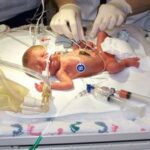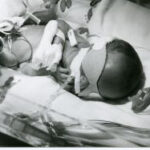What is Kangaroo Care?
The goal of any new parent is to get out of the hospital and home with baby as soon as possible. But with a preemie you have a lot more to overcome before that happens. Weight gain, stable heart rate, stable body temperatures, and the ability to suck…these are just some of the hurdles these tiny infants must achieve before being released. Most doctors will tell you that the rule of thumb for premature infants to be released from the hospital is to go by the 40 week due date. (Obviously, with micro-preemies and other infants with more severe medical conditions, the Neonatal Intensive Care Unit) stay is much longer.)
However, for those preemies that are stable, and for full term infants, one of the best methods of treatment is called, “Kangaroo Care.” Kangaroo Care is skin-to-skin contact with the child’s parents. The baby is placed on the parent’s chest, bare skin to bare skin, just above the parent’s heart. This not only promotes bonding but also promotes growth and weight gain, keeps the baby calm and his body temperature regulated, and can help decrease issues with colic. Another benefit mothers have found is that through this type of bonding, they are able to keep a strong milk supply.
In 1983, neonatalogists Edgar Rey and Hector Martinez in Bogota, Columbia discovered the benefits of Kangaroo Care. The NICU was overburdened and understaffed and the parents had to pitch in even more in the care of the infants. By using this cradling method, the doctors soon saw a decrease in the mortality rate from 70% to 30%. Since then the fame of Kangaroo Care has spread to hospitals all over the world. Many hospitals in the United States still do not practice this but many doctors and nurses will work with parents who wish to use Kangaroo Care.
Why Should Kangaroo Care Be Practiced?
First, one needs to be aware that the NICU is generally a noisy place. Alarms on monitors are constantly going off, babies are crying, et cetera. Hence, it is not a place that promotes sleep. Sleep for preemies is key to growth and development. If that baby can’t rest, he won’t have the energy to learn how to suck or to even put on weight. Kangaroo Care places the baby’s ear next to his parent’s heart and it has been observed that these infants sleep far better. Not only does the sound of mom’s heartbeat remind him of the cozy womb but mom’s skin regulates his body temperature far better than a warming table could. All of that promotes a deep, healthy sleep. Some Kangarooed infants spent less than half the time a non-Kangarooed infant had in the NICU.
Another area Kangaroo Care benefits the baby is seen medically. One of the biggest issues with preemies is difficulty with breathing. Lungs are the last organ to develop and if born prematurely, they run the risk of needing help to breathe. Even after being stabilized, preemies will be at risk for respiratory distress. Kangaroo Care has improved and stabilized respirations in preemies.
Also, doctors have seen a decrease in bradycardia (an abnormal slowing of the heart rate) and apnea (the baby stops breathing for more than 15-20 seconds while sleeping.) These two conditions are common to premature infants. As a parent of a preemie, these conditions frightened me especially when my daughter’s monitor alarm would sound due to bradycardia. She was always on monitors, even when I held her in Kangaroo Care. During Kangaroo Care, her monitor alarms never sounded. Her heart rate was stronger, she slept longer and deeper and never once stopped breathing.
I am very grateful that our NICU practiced Kangaroo Care when my daughter was born. My husband and I both Kangarooed our little girl and we saw a steady weight gain and improvement in her overall health. By 35 ½ weeks gestation, or by the time she was almost 4 weeks old, we were able to take her home. That was four weeks sooner than what the doctor promised.



